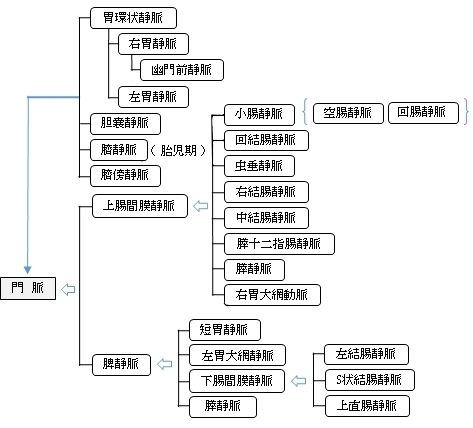
・ 読み方だが、「 日本人体解剖学 」では「ひだりいじょうみゃく」、そして 「 船戸和弥のHP 」では「さいじょうみゃく」となっている。



「 船戸和弥のHP 」では以下のように解説している。
「左胃静脈と右胃静脈とは胃の小弯に沿って冠状に走るので、この両静脈を総称して胃冠状静脈 ( gastric coronary vein ) と呼ぶ。左胃静脈は噴門の近くで食道静脈( 奇静脈の枝 )の末梢枝と吻合する。この吻合は門脈の側副路の一つとして重要である。」
また、以下は「 日本人体解剖学 」の「 胃環状静脈 」の解説文となる。
「 左胃静脈と右胃静脈 left and right gastric veins および幽門前静脈 prepyloric veins が合流して生じ、小弯と十二指腸上部の後ろを右方に走って門脈に入る。胃壁の上部、幽門および十二指腸上部の血液を集める。 」
以下は門脈に注ぐ静脈を簡単に表したもとなる。

 以下の「Wikipedia」の解説文の中で理解できない解説が見受けられる。 以下の「Wikipedia」の解説文の中で理解できない解説が見受けられる。

 インターネットで画像検索をかけてみると、上記の解説文が理解できるようなイラストを掲載しているサイトを発見した。 ⇒ イラスト解説 インターネットで画像検索をかけてみると、上記の解説文が理解できるようなイラストを掲載しているサイトを発見した。 ⇒ イラスト解説
以下は「 Wikipedia 」の解説文となる。
「 The left gastric vein ( or coronary vein ) is a vein carrying deoxygenated blood that derives from tributaries draining both surfaces of the stomach ; it runs from right to left along the lesser curvature of the stomach, between the two layers of the lesser omentum, to the esophageal opening of the stomach, where it receives some esophageal veins.
It then turns backward and passes from left to right behind the omental bursa and drains into the portal vein. Thus, it acts as collaterals between the portal veins and the systemic venous system of the lower esophagus ( azygous vein ).
Esophageal and paraesophageal varices are supplied primarily by the left gastric vein ( due to flow reversal ) and typically drain into the azygos/hemiazygos venous system.[1]」
【 語 句 】
・ deoxygenated :脱酸素化した ・ tributary : 支流 ・ stomach : 胃 ・lesser curvature : 小弯 ・ lesser omentum : 小網 ・ esophageal opening : 食道裂孔 ・ esophageal veins : 食道静脈 ・ omental bursa : 網嚢 ・ portal vein : 門脈 ・ esophagus : 食道 ・ azygous vein : 奇静脈
【 イラスト掲載サイト 】
・ イラストや写真を掲載しているサイト-Ⅰ
・ イラストや写真を掲載しているサイト-Ⅱ
・ イラストや写真を掲載しているサイト-Ⅲ
・ イラストや写真を掲載しているサイト-Ⅳ
・ イラストや写真を掲載しているサイト-Ⅴ

|